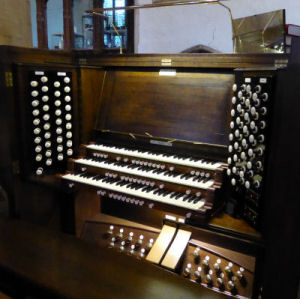The Organ
The organ at Waltham Abbey is at the heart of the life of our church, playing its part in worship, concerts, recitals and in our service to the community through wedding, baptisms and funerals. The instrument has a long history and now comprises a combination of the 1953 Walker instrument and the 2019 re-design, repair and rebuild by Mander Organs.

A Short History of the Organ
The history of the present organ in the Abbey begins with a barrel organ, having 6 stops and a repertoire of 8 hymn tunes, installed in the West gallery exactly 200 years ago in 1819 by the pioneering firm of Flight & Robson. In 1850 this instrument was converted to finger and foot operation and expanded to two manuals in the first of several rebuilds over a little more than a century by Joseph W. Walker (& Sons, in due course).
The Walker firm in its heyday was a significant force in British organ-building. New and substantially new organs included St Margaret’s Church, Westminster (1898) where the famous Edwin Lemare was organist and wrought a considerable influence on the firm’s approach to organ design, York Minster (1903), Bristol Cathedral (1907) and much other work all over Britain and the Commonwealth. In the 1950s and 60s the firm was at the forefront of this country’s response to the neo-Classical ‘organ revival’ movement, which was a move away from trying to make organs sound ever more like a symphony orchestra (and ever louder), and towards a new appreciation of the distinctive, bright, clear tone-colours that only organ pipes can create. Post-‘revival’ Walker organs include the ground-breaking Brompton Oratory (1954), and Liverpool Metropolitan and Blackburn Cathedrals (1960s).
The Waltham Abbey organ was enlarged in 1860, at which point the first proper pedal pipes arrived. However, it was entirely rebuilt in 1879 in a larger form in the North-East corner of the church. A number of stops, including the majority of the third manual were prepared for, and the project was completed in 1893. The final major piece of Walker work was a 1953 rebuild and return to the West gallery, with considerable enlargement of the Choir and Pedal divisions, all very much in spite of restricted gallery space and post-war funding. The magnificent free-standing console dates from this time, as did a less than magnificent pipe front, originally envisaged as temporary but surviving until the current rebuild. (Learn more about the 1953 rebuild)
In 1994, Principal Pipe Organs of York undertook limited refurbishment, and supplied a number of new pipes either in place of or crammed in alongside existing ones. The 1953 rebuild had just missed the ‘organ revival’, and the 1994 project was intended to bring brighter and clearer tones into the organ. Sadly, it was not able to address fundamental problems attributable to accelerated aging of wood and leather in the organ’s elevated position within a centrally heated Abbey, and exacerbated by lack of maintenance access in the cramped gallery to remedy anything without major dismantling. As more and more of the organ failed, it became apparent that more drastic action was needed. It also had to be admitted that the latest additions, which on the face of it delivered what had been asked for and represented good value for limited funds, were not entirely successful musically.
The Latest Rebuild

It so happens that the long and careful tendering process led the parish to contract its local organ builder, Mander Organs of Bethnal Green, East London, whose portfolio includes a thorough rebuild at the Royal Albert Hall and the care of the organs of St Paul’s Cathedral. The final specification was negotiated between John Mander (now retired), Mander’s Tonal Director Michael Blighton whose job it is to ‘voice’ the 2,665 pipes to optimum tone quality, William McVicker, and the Abbey organist Jonathan Lilley, with the Rector, retained architect Sherry Bates and the organ committee having a say on matters affecting the organ’s appearance. Design work and pipe-making were already under way when the old organ was dismantled in July 2018, and re-installation took place April to July 2019.

Over and above the replacement of those pipes felt to be of less than ideal tone quality, there are two significant new stops. One of these is a 16-foot Diapason stop with metal pipes and a clearer tone than the older wooden ones. The introduction of these and the replacement of certain other large pipes bring a most welcome bonus; they are cast in a burnished tin-rich alloy for arranging into an impressive new facade. Secondly, the designers surprised us by finding space after all for a 32-foot reed stop, which comprises the tallest and the deepest-pitched organ pipes in Essex, albeit with half-length resonators for the lowest 6 notes – there isn’t actually a pipe 32 feet long! – and which rounds up the number of ‘speaking’ stops to 50.
How does the Organ Work?
If you would like to know how a pipe organ works, refer to the following web pages:
